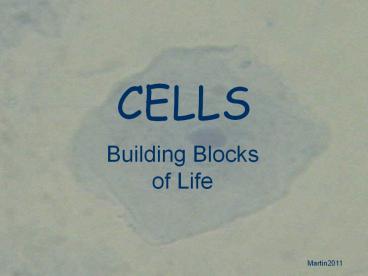CELLS PowerPoint PPT Presentation
1 / 23
Title: CELLS
1
CELLS
- Building Blocks of Life
2
Prokaryotic Cells
- Prokaryotic cells
- Very simple
- Few internal structures
- DNA is NOT enclosed in a nucleus
- NO membrane-bound organelles
3
Examples of Prokaryotic Cells
Photos Daniel Kunkel
4
Eukaryotic Cells
- Eukaryotic Cells
- Very complex
- Many internal structures
- DNA is enclosed in a nucleus
- Many membrane-bound organelles like mitochondria
and Golgi bodies
5
Examples of Eukaryotic Cells
http//library.thinkquest.org/C004535/eukaryotic_c
ells.html?tqskip11tqtime0919
6
Cell Membrane
- Cell membrane
- The protective layer around all cells. The cell
membrane controls what goes in and what goes out
of cells. - The Fence
7
Cell Wall
- Cell Wall
- Tough, rigid outer covering found in plants,
algae, fungi, and bacteria. Animal cells do not
have cell walls. Cell walls protect and support. - The Brick Wall
http//www.tvdsb.ca/webpages/brownt12/files/index1
.htm
8
Cytoplasm
- Cytoplasm
- The gel-like material inside cells. This is where
many of the chemical reactions take place - The Filler
9
The Cytoskeleton
- Cytoskeleton
- Helps the cell maintain OR change its shape. Some
organisms move by stretching and contracting the
cytoskeleton. - The Bones
http//library.thinkquest.org/C004535/cytoskeleton
.html?tqskip11tqtime0919
10
The Nucleus
- Nucleus
- Directs all the activities of the cell. The DNA
in the nucleus contains the instructions for
everything the cell does. The nucleus is
surrounded by its own membrane. - The Brain, The Skull
11
The Mitochondria
- Mitochondria
- Break down food (sugars) into carbon dioxide and
water. This reaction releases the stored energy
in the food, - The Furnace
- The Power Plant
12
Mitochondria at Work
http//www.tvdsb.ca/webpages/brownt12/files/index1
.htm
13
The Chloroplasts
- Chloroplasts
- Use the energy from the sun to convert carbon
dioxide and water into sugars (food). Animal
cells do not have chloroplasts. - The Sugar Factory
14
Chloroplasts at Work
http//www.tvdsb.ca/webpages/brownt12/files/index1
.htm
15
The Endoplasmic Reticulum
- Endoplasmic Reticulum
- One long membrane that connects the nuclear
membrane to the cell membrane. It has many folds.
Proteins and other chemicals move along this
membrane. - The Highway System
16
The ER at Work
http//www.tvdsb.ca/webpages/brownt12/files/index1
.htm
17
The Ribosomes
- Ribosomes
- Made in the nucleolus, these organelles move out
of the nucleus to the cytoplasm. They have no
membranes that surround them. They make proteins. - The Protein Factory
http//www.tvdsb.ca/webpages/brownt12/files/index1
.htm
18
The Golgi Bodies
- Golgi Bodies
- These organelles sort, fold, package, and deliver
proteins and other chemicals to areas inside and
outside the cell. - The UPS Store Sort, Pack, and Deliver
19
Golgi Bodies at Work
http//www.tvdsb.ca/webpages/brownt12/files/index1
.htm
20
The Lysosomes
- Lysosomes
- These contain digestive chemicals (enzymes) that
break down food particles, waste products, and
damaged cell parts for recycling. These are much
more important in animal cells. - The Recycling Center
http//www.tvdsb.ca/webpages/brownt12/files/index1
.htm
21
The Vacuoles
- Vacuoles
- These temporarily store water, food, and waste
materials. These are very large and very
important in plant cells. They also provide
support. - The Closet
http//www.tvdsb.ca/webpages/brownt12/files/index1
.htm
22
References
http//library.thinkquest.org/C004535/introduction
.html
http//www.tvdsb.on.ca/westmin/science/sbi3a1/Cell
s/cells.htm
http//www.youtube.com/watch?v-zafJKbMPA8feature
related
23
Gallery of Cells

